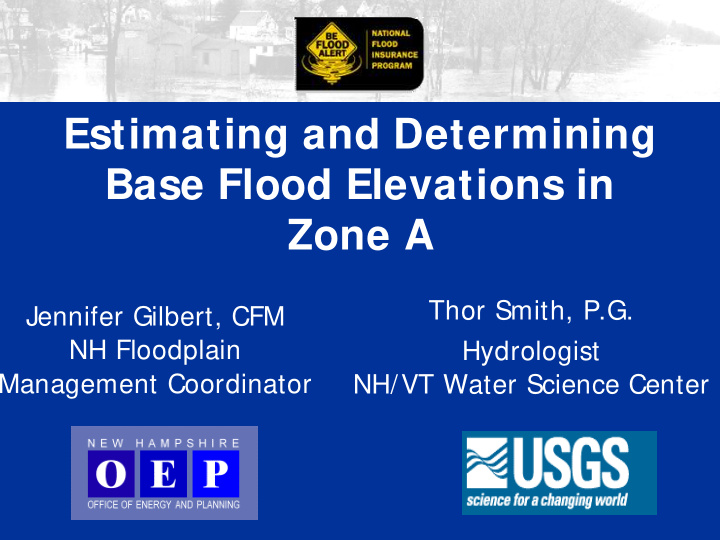



Estimating and Determining Base Flood Elevations in Zone A Thor Smith, P.G. Jennifer Gilbert, CFM NH Floodplain Hydrologist Management Coordinator NH/VT Water Science Center
Overview of Presentation • NFIP Overview • Zone A Regulations, Elevation Certificate, Letter of Map Amendment • Sources of Flood & Watershed Info • Determining BFEs - Simplified Methods • Determining BFEs - Detailed Methods • Question & Answer Session
National Flood I nsurance Program in New Hampshire • 203 communities (86%) participate • 32 communities (14%) do not participate
National Flood I nsurance Program – The 3 Parts • Floodplain Regulations • Floodplain Mapping • Flood Insurance
Map Mod in New Hampshire • Effective DFIRMs and FIS – Rockingham - May 17, 2005 – Strafford - May 17, 2005 – Cheshire - May 23, 2006 – Sullivan - May 23, 2006 – Grafton – February 20, 2008 • Preliminary DFIRMs and FIS – Merrimack final in 2009 – Hillsborough final in 2009
Differences between FI RM and DFI RM Dover
Where Can I get a Map or Study? www.nh.gov/ oep/ programs/ floodplainmanagement/ maps.htm
Flood Lines Newsletter • NH NFIP newsletter • Email distribution list • To be added go to: www.nh.gov/oep/ newsletters.htm
What is a Base Flood Elevation? The height above sea level to which flood water would be expected to rise in a base, 1% chance, or 100-year flood event.
Why are there Zone As with no BFE? • Not cost effective in areas where there is no or little development • Zone A Floodplain areas based on approximate methods or historical flood data
FEMA Guidance Document Managing Floodplain Development in Approximate Zone A Areas www.fema.gov/plan/prevent/fhm/ dl_zonea.shtm
BFE Sources • Community shall obtain, review, and reasonably utilize any 100-year flood elevation data available from any federal, state, or other source including data submitted for development proposals submitted to the community (i.e. subdivisions, site plan approvals)
I f no source of BFE, now what? • Development > or = to 50 lots or 5 acres • Development < 50 lots or 5 acres • Elevation Certificate • Letter of Map Amendment
Development Greater Than 50 Lots or 5 Acres • NFIP language in a Community’s Subdivision & Site Plan Review Regulations: The Planning Board shall require that all proposals for development greater than 50 lots or 5 acres, whichever is the lesser, include Base Flood Elevation (BFE) data within such proposals (i.e. floodplain boundary and 100-year flood elevation). • Detailed Study Needed
Development Greater Than 50 Lots or 5 Acres (cont.) • Proposed 12 lot/ • Proposed 76-lot 6.7 acre subdivision subdivision • BFE data required • BFE data required for affected lots for affected lots
Development Greater Than 50 Lots or 5 Acres (cont.) • Proposed 76-lot subdivision • Entire Zone A contained entirely in open space lot • BFE data may not be necessary
NH Community I nitiative Town of Bedford Requires that all subdivision and site plan development proposals include the BFE. The town defines a methodology for a floodplain determination if a BFE is not defined on the FIRM.
Advantages of Developing BFEs • Minimizes and reduces future flood losses • Less burden on community officials • Significant reduction on flood insurance • Eligible for sizable credits under the Community Rating System
Development Greater Than 50 Lots or 5 Acres (cont.) • When a developer prepares a detailed flood study to determine a BFE, community is responsible for submitting new flood data to FEMA within 6 months • Community can require developer to submit a request for a Letter of Map Revision as a condition of approving the development
Development Less Than 50 Lots or 5 Acres • Community shall review all building permit applications for new construction or substantial improvements to determine whether proposed building sites will be reasonably safe from flooding.
Development Less Than 50 Lots or 5 Acres (cont.) • Use Simple Method to Estimate BFE • Lowest floor elevated 1 to 2 ft above the experienced flood event • Lowest floor elevated 2 to 5 ft above highest adjacent grade
Post-FIRM Zone A - No Basement/Enclosure $100,000 Bldg Coverage Estimated Annual Cost Elevation No Estimated Estimated BFE Difference BFE + 5 feet or More $230 $245 + 2 to + 4 feet $610 $245 + 1 feet $1,345 $560 0 Submit for Rate $560
Elevation Certificate • Rate a Flood Insurance Policy • Assist a community’s floodplain management program • Support a FEMA Letter of Map Amendment application
Elevation Certificate (cont.)
Elevation Certificate (cont.)
Elevation Certificate (cont.)
Elevation Certificate (cont.)
Letter of Map Amendment A letter from FEMA stating an existing structure or parcel of land that has not been elevated by fill would not be inundated by the base flood.
Letter of Map Amendment (cont.) • MT-EZ Application Form – Section A – Property Information – Section B – Elevation Data • An Elevation Certificate can be submitted in lieu of Section B
Letter of Map Amendment (cont.)
Letter of Map Amendment (cont.)
Submitting a LOMA without a BFE • FEMA will determine the BFE in Zone A • Additional survey data may be needed to make determination • Vermont guidance on Surveying for a LOMA in “Zone A”
Questions? Contact I nformation Jennifer Gilbert NH Office of Energy and Planning (603) 271-2155 jennifer.gilbert@nh.gov www.nh.gov/oep/programs/ floodplainmanagement/
Recommend
More recommend